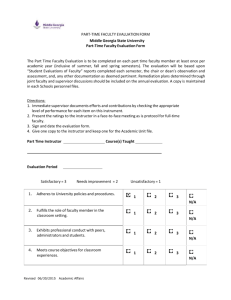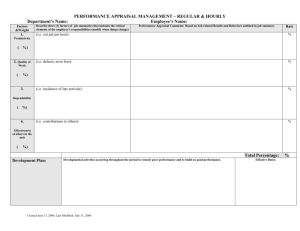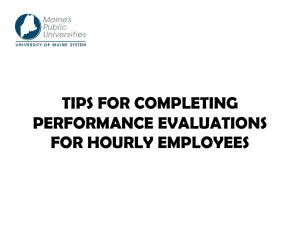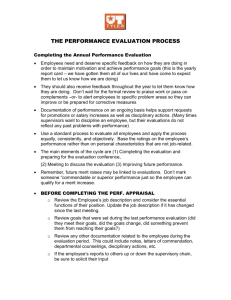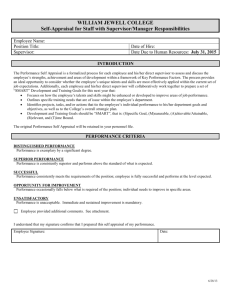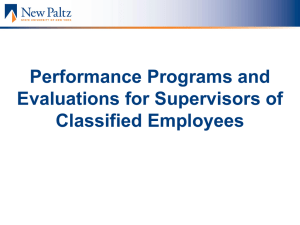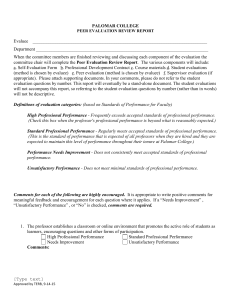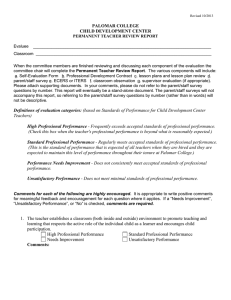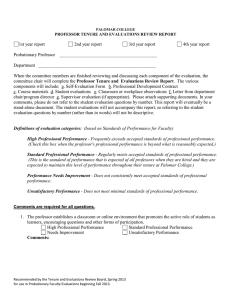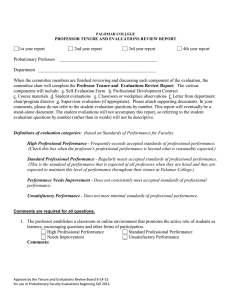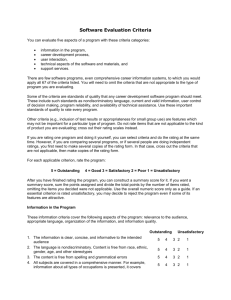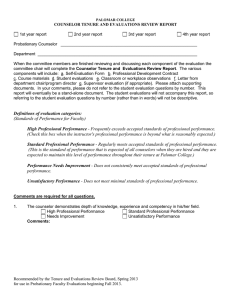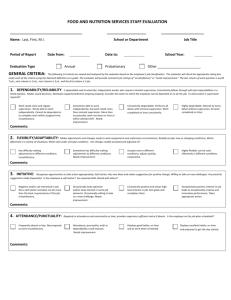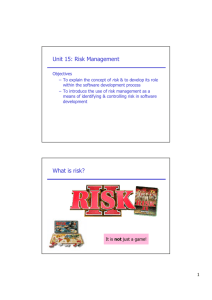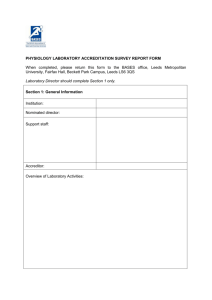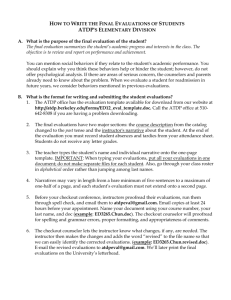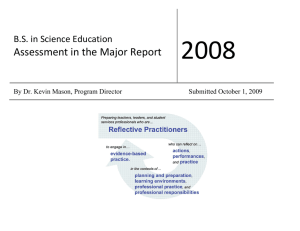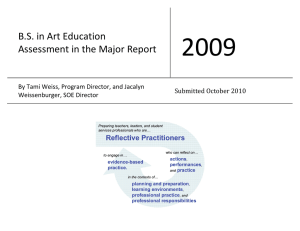word - Domuskids.org
advertisement
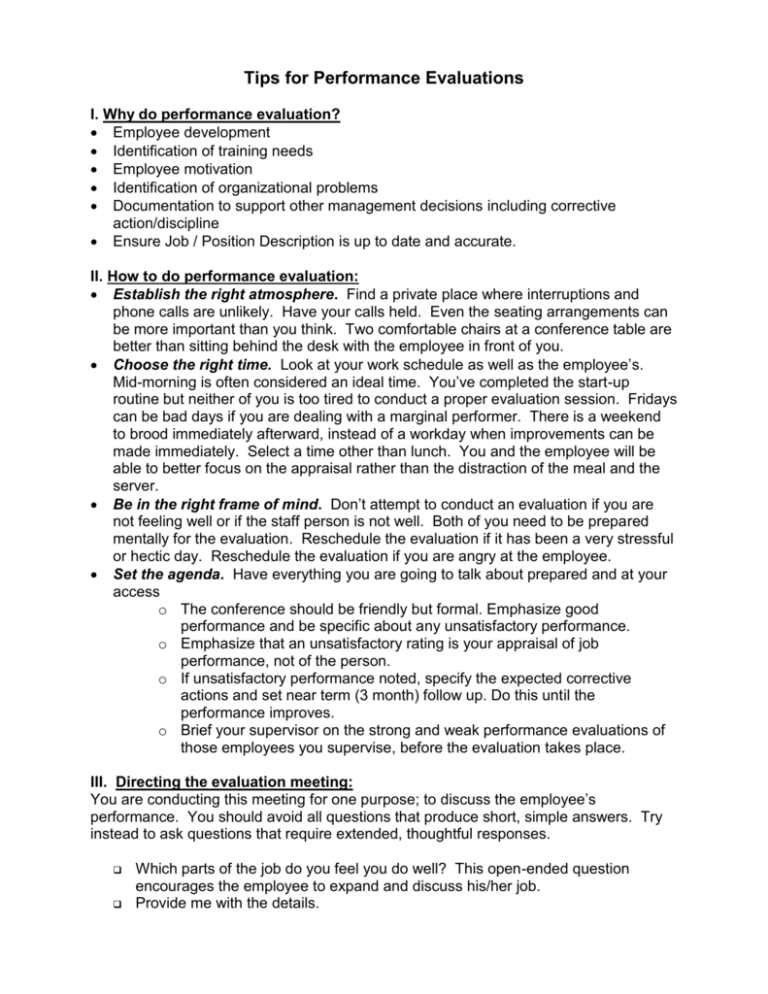
Tips for Performance Evaluations I. Why do performance evaluation? Employee development Identification of training needs Employee motivation Identification of organizational problems Documentation to support other management decisions including corrective action/discipline Ensure Job / Position Description is up to date and accurate. II. How to do performance evaluation: Establish the right atmosphere. Find a private place where interruptions and phone calls are unlikely. Have your calls held. Even the seating arrangements can be more important than you think. Two comfortable chairs at a conference table are better than sitting behind the desk with the employee in front of you. Choose the right time. Look at your work schedule as well as the employee’s. Mid-morning is often considered an ideal time. You’ve completed the start-up routine but neither of you is too tired to conduct a proper evaluation session. Fridays can be bad days if you are dealing with a marginal performer. There is a weekend to brood immediately afterward, instead of a workday when improvements can be made immediately. Select a time other than lunch. You and the employee will be able to better focus on the appraisal rather than the distraction of the meal and the server. Be in the right frame of mind. Don’t attempt to conduct an evaluation if you are not feeling well or if the staff person is not well. Both of you need to be prepared mentally for the evaluation. Reschedule the evaluation if it has been a very stressful or hectic day. Reschedule the evaluation if you are angry at the employee. Set the agenda. Have everything you are going to talk about prepared and at your access o The conference should be friendly but formal. Emphasize good performance and be specific about any unsatisfactory performance. o Emphasize that an unsatisfactory rating is your appraisal of job performance, not of the person. o If unsatisfactory performance noted, specify the expected corrective actions and set near term (3 month) follow up. Do this until the performance improves. o Brief your supervisor on the strong and weak performance evaluations of those employees you supervise, before the evaluation takes place. III. Directing the evaluation meeting: You are conducting this meeting for one purpose; to discuss the employee’s performance. You should avoid all questions that produce short, simple answers. Try instead to ask questions that require extended, thoughtful responses. Which parts of the job do you feel you do well? This open-ended question encourages the employee to expand and discuss his/her job. Provide me with the details. Please elaborate. IV. Providing feedback: Make the feedback specific. Sometimes employees just don’t measure up to the performance standards. You have to point this out, and it won’t be easy. Some supervisors try to avoid this experience. They hope the employee’s performance will improve with time, experience, or just luck. Usually, the result is just the opposite. Employees conclude that their performance is acceptable and no one tells them anything different until they are fired (worst case scenario). In a case like that, a huge wrongful discharge claim could be filed because evaluations didn’t reflect the actual performance. Performance feedback needs to be constructive in order for it to be productive. It tries to reinforce the positive and change the negative by: Identifying what was done well or poorly. Describing what action or behavior is desired. Explaining the effects of the observed and desired acts or behavior. Constructive feedback focuses on the behavior, not the person. Consider the employee’s feelings; focus on the action, not the person. Avoid attacking the individual and making judgments. Encourage the employee to listen rather than be defensive. Let the employee know what behavior is expected. Explain how you want inadequate behavior changed. Explain the results or effect of the action or behavior. Take time to point out positive behaviors that can be repeated and work with the employee to come up with ways to repeat those behaviors. Follow up with more feedback and action plans as needed. V. Evaluation errors: "Halo and horns" effect - a general impression colors the rating on all factors. Treat each factor separately. "Recency" effect - the evaluation is based upon the last three or four weeks of performance rather than the totality of the evaluation period. "Central tendency" - fence straddling by the evaluator who is unwilling to assign appropriate high or low ratings. "Rater bias" - personal prejudice against the employee. VI. Administration: An employee's signature on the evaluation form does not necessarily imply agreement with the evaluation, only that the employee has participated in the evaluation. Written memoranda documenting performance through out the year should be attached to the evaluation report. Performance appraisals should be signed by the supervisor. The signed report and the employee's comments and other documents must be filed in the employee's personnel folder and stored in a secure place not readily accessible by employees. The personnel file should be made available to the employee upon request but under controlled circumstances to prevent loss of critical documentation.
